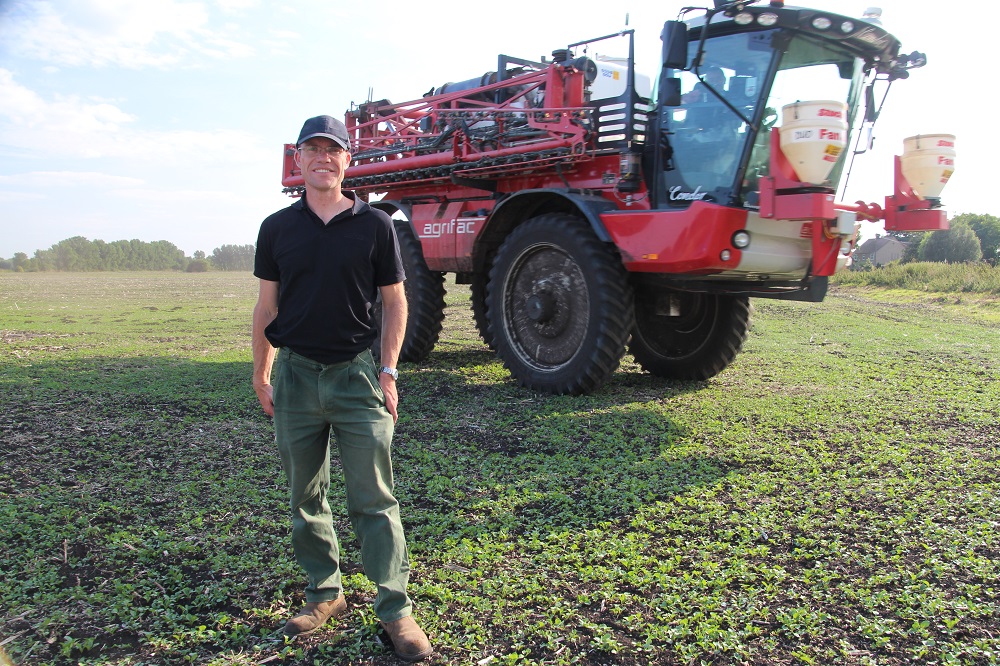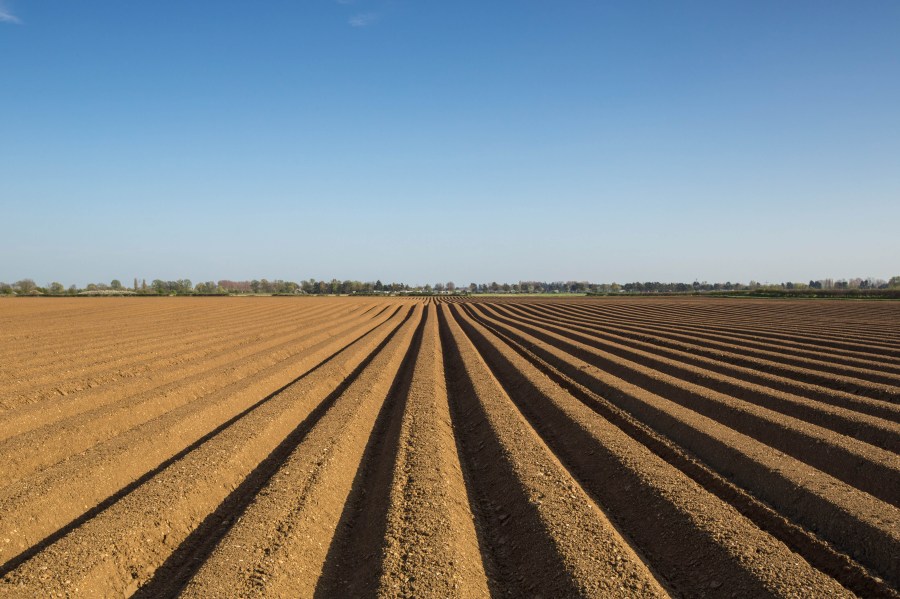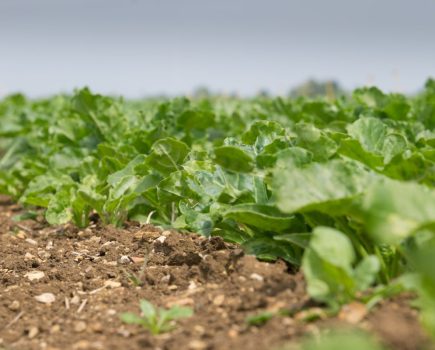In an era where potato products are disappearing more quickly than the innovation pipeline can deliver new ones, things are looking up with the arrival of a new SDHI and another well on its way. CPM finds out how they’ve performed in grower experience trials
Fast, even crop emergence aids the management of the crop for the entire season.
By Lucy de la Pasture
New product launches are few and far between these days, so the launch of BASF’s Allstar is welcome news for potato growers and offers an alternative treatment to Amistar (azoxystrobin), explains Paul Goddard, BASF technical lead for potatoes.
The active ingredient in Allstar is fluxapyroxad (300g/l), already familiar to cereal growers as the active in BASF’s cereal SDHI fungicide Imtrex (62.5g/l). It’s applied as an in-furrow treatment, in the same way as Amistar, and has comparable efficacy on rhizoctonia (Rhizoctonia solani) and black dot (Colletotrichum coccodes), notes Paul.
But the new chemistry also brings with it some added benefits, over and above disease control. And it’s these that have particularly caught the attention in 50 on-farm trials that were set up as part of a grower experience programme in 2017 across the length and breadth of the UK.

Tubers from plots treated with Allstar have been reported to have a bloom to their skins, enhancing their skin finish.
Early in the season, rhizoctonia stem canker causes delayed emergence and stolon pruning, resulting in crops of uneven size and maturity. Treatments applied to control the disease are also known to delay crop emergence slightly and any grower or agronomist of a certain age remembers the dire effects on crop emergence when new seed treatment Gambit (fenpiclonil) was first applied in the late 1990s and quickly withdrawn soon after. When it comes to Allstar, Paul says with absolute confidence that treatment is exceptionally kind to the crop, with minimal delays observed in emergence and sometimes no delay at all.
“2017 was a very benevolent season, with crop emergence generally good,” says Paul. “For Allstar treated crops, emergence was often the same as for untreated crops and quicker than where crops were treated with Amistar. In a cooler spring I’d expect the differences to more marked.
“Fast, even crop emergence aids the management of the crop for the entire season – helping with everything from weed control to tuber uniformity, skin set and dry matter,” he explains.
During the season, rhizoctonia causes a number of symptoms on the tuber, including netting or elephant hide, growth distortions and the characteristic black scurf symptoms caused by the sclerotia of the fungus.
“One of the most noticeable effects of Allstar is a ‘bloom’ to the skins of treated tubers, making the sample visually appealing. It’s this effect that caught the attention of the majority of the grower-experience group, who rated skin finish and marketability of tubers harvested as better than the Amistar alternative.”
Jonah Ehmann, potato production manager at Greenseed International, was one of the growers that took part in BASF’s grower-experience trials across the UK, enabling them to have a look-see at Allstar in their own commercial situation.
Jonah has 600ha of potatoes under his wing in West Norfolk and chose to try Allstar alongside his usual rhizoctonia treatment of Amistar on a crop of Maris Peer, grown for the baby-new pillow pack market. It’s a crop where size and skin finish are all-important and the stolon pruning and patchy emergence resulting from rhizoctonia infection can have a tremendous effect on the uniformity of tubers, reducing marketable yield of tubers in the target range of 25-45mm.
“We applied the Allstar in-furrow to five beds of Maris Peer using a Team Sprayer with Dosatron and noticed emergence 1-2 days earlier than the Amistar treated beds. When we came to assess the differences between the two treatments using yield digs, there were more tubers in the 25-45mm size fraction, giving a 1.5t/ha increase in marketable yield in the Allstar-treated beds. There was also less common scab on tubers,” he notes.
This reduction in the severity of common scab was observed in other trials but Paul doesn’t believe that it’s due to a direct effect of the fungicide treatment. “I think there’s an indirect effect on common scab where the Allstar effectively tightens the period of tuber initiation (by controlling rhizoctonia), which makes it easier to time irrigation during this window to prevent common scab.”
In addition to rhizoctonia, Allstar has an effect on black dot, another important skin blemish disease. “Good efficacy has been shown in the lab, with field studies confirming a useful reduction in the field. An observation from a crop of Estima in the Grower Experience Programme showed Allstar and Amistar to have equivalent efficacy – 13% and 14% mean coverage respectively.
“But this assessment didn’t capture that the symptoms were more pronounced in the Amistar treated sample, looking to be more mature with a greater degree of the bronzing associated with the disease,” he says.
Branston agronomist Kevin Hall carried out a trial looking at different fungicide treatments at planting as part of his BASIS qualification. The trial was carried in 2017 in Angus, Scotland within a commercial crop of Maris Piper grown on a sandy loam soil.
“The purpose of the trial was to try and establish if the use of commercial fungicide products would improve skin finishes and increase the marketable yield. The trial was split into four plots with treatments of Maxim (fludioxonil), Amistar, Allstar and a control plot. The focus was on the effects of black dot, black scurf, silver scurf and common scab on marketable yield,” explains Kevin.
The trial site was unirrigated and black dot risk assessed as low, according to the results of soil samples analysed by SRUC in Aberdeen. The Maxim treated seed was applied on 20 Feb over a roller table at a rate of 250 ml/t in 2.0 litres of water and the in-furrow treatments, Amistar at 3 l/ha and Allstar at 0.8 l/ha, were applied at planting on 1 May.
“The plot treated with Allstar established quicker than the other treated plots. Amistar and the untreated plot followed closely behind, while the Maxim treated plot emerged four days later. Test digs from one plant were completed on 24 July across all 4 plots and showed the Maxim and Allstar treatments produced more tubers and were uniform in size. The Amistar and untreated plots produced lower tuber numbers and were less uniform in size,” notes Kevin.

“Amistar had similar pick off as the Allstar plot but the Amistar produced more growth cracks than other plots,” he adds.
Perhaps where Allstar really proves itself is in ease of application, Paul suggests. “We’ve tested it through a variety of applicators, including Team, Grimme and Techneat, and the smooth-flow formulation is proving very kind to the equipment.
“The formulation is slow to settle out and has a reduced potential to block nozzles. Allstar can also be applied through the Dosatron applicators used to apply Amistar but the lower rate means the container washings must be used to bulk up the concentrate,” he adds.
Trial shows nematicide combo works best
A new nematicide being developed by Bayer has the potential to form part of an integrated strategy for PCN management. That’s the conclusion Produce Solutions agronomist Alistair Neill drew from a trial he ran last year in a pre-pack crop on Holbeach Marsh.
“The pressure on the few options currently available is huge so we were keen to try it out,” Alistair says. Currently referred to by its development code AR83685, this novel nematicide is based on the SDHI active substance fluopyram – an active already used as a fungicide – which works by inhibiting ATP production in mitochondria. ATP is the fuel that cells need to operate, so when its production is inhibited the nematode becomes paralysed and then dies.
“A major attraction for growers will be its liquid formulation designed for ultra-low dose application at a rate of 625 ml/ha delivering 250 g/ha of active substance.”
Alistair constructed the trial to compare the efficacy of AR83685 against Nemathorin (fosthiazate), a combination of Nemathorin and AR83685, and an untreated control. The trial site was a loamy silt where sampling had indicated a PCN population of 8.6 eggs per gram of soil, which he says is not uncommon for the area where many fields have PCN present.
The field was already destined for a crop of variety Nectar which has a resistance rating of 1 against G. rostochiensis and G. pallida. This means in the presence of PCN, populations could potentially increase dramatically. Anecdotally Nectar is reported to be fairly tolerant to PCN and Alistair says this was borne out by the trial.
Nemathorin was applied at 30 kg/ha overall, then incorporated to 15cm with a rotavator. AR83685 was applied in-furrow at 625 ml/ha. Emergence and groundcover were monitored using the NIAB-CUF ‘CanopyCheck’ app and root invasion prognosis was carried out at Harper Adams University to identify how many juveniles were able to invade the roots.
While there were no significant differences between the treatments at emergence and canopy expansion, the root invasion prognosis gave an interesting insight into the novel nematicide’s role. Nemathorin reduced invasion by 40% and AR83685 reduced it by 53%, when compared with the untreated plot, where root invasion was 450 juveniles per gram of root matter. The best result was from the combination of AR83685 plus Nemathorin which reduced invasion by 58%.
Alistair suggests this could be due to the nematicides’ complimentary application methods, with the in-furrow applied AR83685 providing early protection around the seed tuber and backed up by Nemathorin’s activity through the bed profile.
From these root invasion results he believes that a combined approach will work best. “Integrating with other granular nematicides through the bed profile, at potentially lower rates, could be a valuable method of sustaining existing nematicide chemistry. With a completely new mode of action and an anticipated harvest interval shorter than current nematicides, AR83685 looks set to be a valuable tool for growers, particularly on short-season crops where PCN management is currently restricted by longer harvest intervals.”
Go large with PCN sample size
SASA’s Dr Jon Pickup warns there can be no short-cuts when sampling for PCN. Speaking at the AHDB Agronomist Conference last Dec, he explains that the less soil tested means there’s a lower chance of detection.
“No detection doesn’t necessarily mean freedom from PCN — populations take time to reach a detectable threshold,” he explains.
Sample size is the key to getting a more reliable result from sampling, with larger soil samples providing a more accurate population estimate. “Increasing the number of cores taken is more important than increasing core size. The minimum number of samples taken per ha should be 49, sampling using a 7 x 7 grid system,” he suggests.
Sub-sampling for analysis in the lab is another area where inaccuracies can creep in and Jon advises that samples should be thoroughly mixed before any sub-samples are taken.
“For very high PCN populations (100 eggs/g), small subsamples of 100g are acceptable but where intolerant varieties are to be grown on light sandy soils, larger subsamples (minimum of 400g/ha) should be analysed to increase the possibility of detection,” he concludes.
New blight strain means fungicide rethink
The emergence of a new strain of potato late blight (Phytophthora infestans) with resistance to fluazinam is creating concern among agronomists. After five cases of 37_A2 (Dark Green 37) were confirmed in the UK in 2016 it’s spread, mainly to neighbouring counties around the Midlands, but also as far as Kent.
“From only a handful of cases in 2016, we’ve seen more than 40 confirmed cases in 2017,” says Darryl Shailes, Hutchinsons potato agronomist. “In what was a relatively low-pressure year, this is an alarming rate of expansion with incidents in Kent, Shrops, North Yorks, Cheshire, Staffs and Derbys.”
According to the genotyping data presented by Dr David Cooke at the AHDB Agronomist Conference, the prevalence of 37_A2 has increased from just 3% of isolates tested in 2016 to 24% in 2017. An increased incidence of tuber blight in store has further pointed the finger towards the ingress of the fluazinam-insensitive strain.
Although little is known about this strain, it’s proved to be highly aggressive. More information on the phenotype of 37_A2 will be emerging from the EU project IPMBlight 2.0, being led by Dr Didier Andrivon at INRA in France.
For many years fluazinam has been a mainstay in most programmes and has proved to be amongst the most effective actives on 13_A2. It’s possible that such frequent use has increased the selection pressure on fluazinam, says Darryl. This raises questions about how best to manage blight at the start and end of the programme, the main fluazinam usage period, he notes.
John Keer, agronomist for Richard Austin Agriculture Services, shares this concern. “We need to look at using something other than fluazinam, both early and at the tail-end of programmes. I don’t see that we can risk it when there’s a new strain and we don’t know how dominant it will be. Fortunately, we haven’t seen any in East Anglia yet, but that can change,” he says.
Both Darryl and John have a similar answer to this conundrum and suggest making more strategic use of Infinito (propamocarb+ fluopicolide) by bringing forward applications to the start of the season.
“It’s the start of the season which concerns me most,” says John. “The only time I’ve ever had trouble controlling blight is when it’s got in early and got away. I regard the first three blight sprays as being very important, so will look to use Infinito here where possible,” he says.
But both agree that tuber blight protection remains a priority. “In recent years we haven’t seen much tuber blight, even though we’ve had seasons with high pressure. It seems that 37_A2 is equally threatening to tubers as it is to foliage,” says Darryl.
“We still have Ranman (cyazofamid), Percos (amectoctradin+ dimethomorph) and Presidium (dimethoorph+ zoxamide) to use for tuber blight. But 37_A2 may prove more of a threat than we’ve seen with either 6_A1 or 13_A2, so the flupicolide in Infinito will remain important here too,” he adds.




